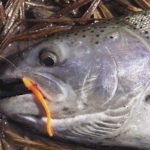Northern Minnesota has a season which doesn’t have a name: the uncertain time between winter and spring. It’s when midday sunshine and warm temps get you thinking spring is just around the corner, but the nighttime temps drop to single digits, ensuring the hip-deep snow on the ground stays put. That’s when the first migrating crows appear.
Some of us get a little stir-crazy then. Tired of the semi-hibernation that winter forces upon us, we want to get outside and savor some sunshine. When I was a kid, Dad would say, “Let’s go crow hunting.” This was back when crows were an unprotected species and thus not covered by hunting seasons. That said, our excursions after crows were largely hunts in name only.
We’d take the “crow gun,” a single-shot, bolt action Colt .22 Magnum rifle. Mounted with a little scope, the crow gun had uncanny accuracy to 100 yards. Then we would slowly cruise along backroads, hoping to find an unsuspecting crow perched in a tree. I’m not sure there is such a thing as an unsuspecting crow. If there is, we never saw one. Inevitably, our crow hunt would end up with a little target shooting with the crow gun. To my knowledge, the little Colt rifle never killed a crow.
Even though our crow hunts were unsuccessful, I thoroughly enjoyed them. It was fun to get out with Dad and roam around. Looking back, just doing that mattered far more than killing a crow. Although the 12-year-old me may have felt differently.
Later, when spring really arrived, we’d go fishing. Steelhead in the North Shore’s Knife River were usually first on the docket, followed by smelt and brook trout. Dad worked afternoons, so he often went fishing on weekday mornings when I was duty-bound to attend grade school. I’d eagerly await to hear the stories from his time on the river. Often, I had stories of my own, because my afterschool hours were spent seeking brook trout in neighborhood creeks.
Dad enjoyed trout fishing, but at some point, generally a week or two before the fishing opener, we’d spend a sunny day fishing for suckers. For Dad, sucker fishing was a rite of spring. His favorite destination was the Nemadji River, a wonderful waterway that runs red due to its prominent clay banks. The Nemadji begins in Minnesota south of Duluth, then swings into Wisconsin where it flows into the St. Louis River estuary. Fed by clear, spring-fed trout streams, the Nemadji hosts migrating trout from Lake Superior that spawn in these tributaries. It is also accessible to the plethora of fish species that live in the estuary. Even though we were fishing for suckers, Dad would always say, “You never know what you’ll catch in the Nemadji.”
Sometimes, if no one was around, we’d fish the big pools just downstream from the State Hwy 23 bridge. The fishing was pretty easy. All we did was let a worm lie on the bottom and wait for a sucker to pick it up. Most of the suckers we caught weighed a pound or two. Sometimes we caught more creek chubs than suckers.
What did we do with them? As I recall, we brought home the suckers, cleaned them and then ran the filets through a hand grinder to break up the bones. Then Mom made fish patties with them. Like everyone else back then, the “rough fish” we didn’t keep were unceremoniously tossed on the bank. Popular spring shore-fishing spots were littered with rough fish carcasses. I’d like to think such behavior is an artifact of the past.
If we were feeling adventurous, we’d walk upstream from the Hwy 23 bridge to the mouth of a tributary trout stream, the Blackhoof River. If we were after trout, we’d fish the Blackhoof. For suckers, we fished the big hole where the two rivers met. Once, in the midst of sucker action, my bait was slammed by an underwater rocket. A few exciting minutes later, I landed my first steelhead. From such humble beginnings, a steelhead angler was born.
While Dad was a sucker man, trout fishing was always what I liked best. Usually, I’d pester him to try one of the nearby trout streams. I recall that one evening when we fished for a short time in the South Fork of the Nemadji, where I caught two 12-inch brown trout amidst endless swarms of creek chubs and small suckers. It was a feat I never repeated.
While I haven’t carried on Dad’s sucker fishing tradition, I still catch plenty of them every spring, most often while fishing for steelhead. But I catch them in other places, too. One of my favorite stocked trout lakes contains so many suckers that they take dry flies during the July mayfly hatch. They make a crazy sucking sound as they feed on the surface. Years ago, I was fly-fishing unfamiliar water at dusk, casting a big Wooly Bugger in the current where a trout stream entered a walleye lake. I hooked a strong fish and did battle in the failing light, curious as to what species was on the end of my line. A monster brook trout was my hope, but I would have settled for a big walleye. Eventually, I slipped my hand around a six-pound white sucker, my personal best for that species. Honestly, landing that sucker wasn’t a disappointment.
While I didn’t become a crow hunter or a sucker fisherman under Dad’s tutelage, that wasn’t his intent. All he wanted to do was spend some time outdoors with his kid. A day spent sitting on a sunny river bank with a fishing pole propped up on a forked stick, waiting for a sucker to bite, is better than most alternatives. And that lesson has stayed with me through life. In all hunting and fishing, just getting out there is reason enough to go do it.





